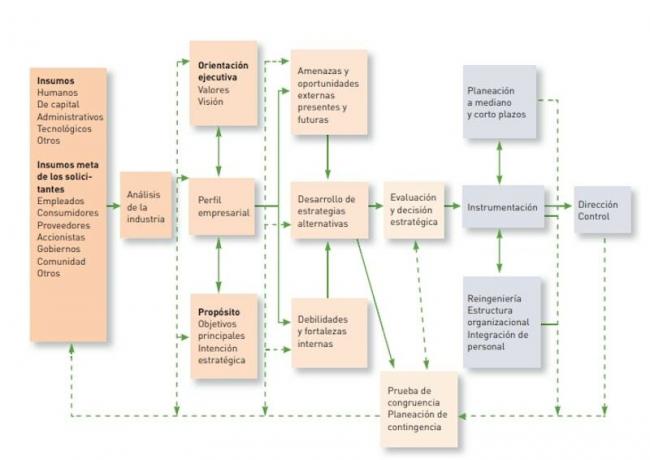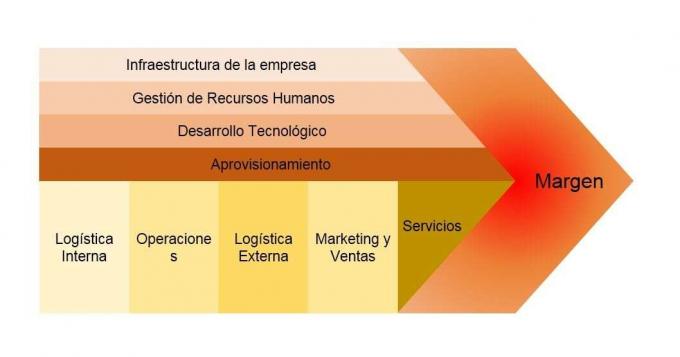The strategic planning process consists of a series of steps and elements that allow companies to develop efficient and effective strategies, whether competitive, corporate, functional or other.
Advertisements

However, the business strategic planning process may involve different steps or phases that vary. depending on the type of strategy to be implemented, but, although there is no single strategic planning process, there is elements at a conceptual level that prevail in all these processes, which we will break down below.
To do this, we will take as reference the elements of the strategic planning process mentioned by Harold Koontz, in his book “Administration, a global and business perspective,” Let's see what this is about.
In this article you will find:
What is the strategic planning process?
Strategic planning is a managerial management tool which consists of establishing a planning process systematic for decision making, establishing objectives, creating an action plan and defining deadlines, taking into account different internal and external factors.
In this way, a line of action is established that directs efforts to achieve the objectives and goals efficiently and effectively.
Elements of the strategic planning process
The strategic planning process, regardless of the type of strategy to be implemented, requires analysis of elements internal and external to the organization for it to be effective, these elements are:

Organization inputs
They are all those resources implemented to carry out the transformation process and obtain results from themThese include human capital, management skills, knowledge, financial and material resources, technological resources or others.
Applicants' target inputs
The organization's goal inputs are all those economic agents or groups of people who hope to obtain a benefit from the company, Harold Koontz (2012) describes it as “employees who want higher salaries, more benefits and job security; consumers who demand safe and reliable products at reasonable prices; suppliers who want to ensure that their products will be purchased; Shareholders, in addition to a high return on their investment, want security for their money; The federal, state and local governments depend on the taxes paid by the company,…” (p. 27).
Industry analysis
The analysis of the industry in the strategic planning process is essential, since in this way you can know the attractiveness of the industry and its viability, from analysis of the external environment.
The analysis of the external environment involves knowing how competition develops within the industry, and the possibilities and barriers for new companies enter the market, as well as the existence of substitute products or services, and the ability to negotiate with suppliers and consumers.
Company Profile
The company profile, as expressed by Harold Koontz (2012), is “The starting point to determine where the company is and where it should go.” (p. 132).
In this way, management can establish the company's mission that directs the direction to follow, taking into account your market segmentation, that is, to which segment you want to direct your efforts and strategies, and to which geographic areas, local, regional or even international.
Orientation, values and vision of executives
For Harold Koontz (2012), orientation and values “They are important aspects to formulate the strategy; “They establish the organizational climate and determine the direction of the company.” (p. 133)
Basically, orientation and values are principles or corporate qualities thatguide management and employees to work towards common objectives, which helps direct the company, in harmony with the vision of the executives.
Harold Koontz (2012) also expresses that the vision of executives “It also determines the direction of the organization by answering the question: what do we want to become?” (p. 133). Hence, the orientation, values and vision of the executives work in coordination, since any of these influence the strategy to be followed.
Mission, main objectives and strategic intention
The mission in other words isthe purpose of the company for Harold Koontz this must answer the questions What is our business? and What business am I in?, The objectives, on the other hand, are the desired final result and where the entity's activities should be directed.
Regarding strategic intention, Harold Koontz (2012) defines it as “the commitment to winning in the competitive environment.” (p. 133)
Hence, this strategic intention be interpreted by different authors as the degree of personal effort and commitmentwith the fulfillment of the organization's goals in the competitive environment, as a declaration of intention or purpose that is pursued and that prevails in the long term, this being the essence of winning of the organization.
External environment, present and future
In the external environment, present and future of organizations, opportunities and threats are studied and analyzed, in order to carry out an evaluation of the competitive environment, taking into account different factors, legal, political, economic, technological, social, and products and services in the market in which it participates, to know your competitive position.
Internal environment
The internal environment represents the study and analysis of internal factors of the entity, taking into account their strengths, weaknesses and resources, for Harold Koontz (2012) these have to do with “research and development, production, operation, purchasing, marketing, products and services.” (p. 134).
Development of alternative strategies
For the development of alternative strategies internal and external factors must be taken into account to the organization, for a comprehensive approach, that allows developingdifferent types of viable strategies for the achievement of the objectives.
Evaluation and choice of strategies
Once different possible alternatives have been developed, we must evaluate the viability of each of the alternatives to choose the most appropriate one, taking into account the risks involved in each of these, the appropriate time to apply, and the relationship with the competition.
Well, as Harold Koontz says (2012) “Perhaps some profitable opportunities are missed, because failing in a risky project would cause the company to go bankrupt.” (P. 135). Therefore, prior evaluation of strategies is essential before choosing an alternative.
Consistency testing and contingency planning
Another of the fundamental elements or aspects of strategic planning is congruence testing and contingency planning.
The congruence test It is an evaluation that It is carried out throughout the strategic planning process, which consists of analyzing the relationship between what is said and what is done, that is, analyzing whether the actions coincide with the planned ideas or if they contradict them, being aspects that must be corrected or avoided.
On the other hand, the contingency planning, consists of developing plans that allow us to be better prepared for those future events that cannot be predicted and that have a high level of uncertainty.
Medium and short-term planning, instrumentation through organization, personnel integration, direction and control
As seen in the diagram of the strategic planning process outlined by Harold Koontz (2012), medium and long-term planning short terms, instrumentation through organization, integration of personnel and management and control, are highlighted in gray, this is due to that They are not elements that are part of the strategic planning process, but they must be considered within the process.
Bibliographic references:
Harold Koontz, et al, (2012) "Administration. A Global and Business Perspective”; Mexico. McGRAW-HILL/Interamericana Editores S.A. of C.V.


